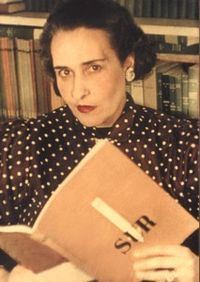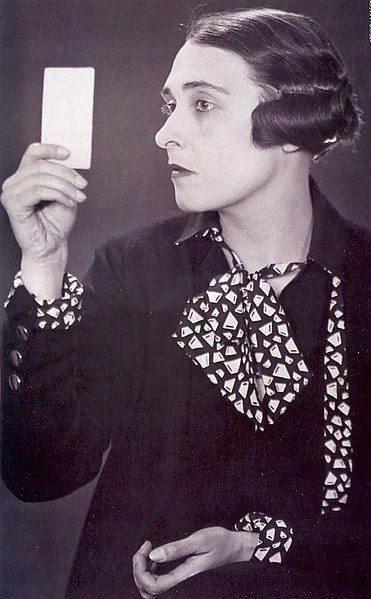Nationality Argentina Nieces Marta Bioy Ocampo Role Writer | Name Victoria Ocampo Alma mater University of Paris | |
 | ||
Occupation writer and intellectual Died January 27, 1979, Beccar, Argentina Books 338171 T.E. (Lawrence of Arabia), Testimonies: Alberdi and Sarmiento in Modern Argentine Life Parents Manuel Ocampo, Ramona Aguirre Siblings Silvina Ocampo, Rosa Ocampo, Clara Ocampo, Francisca Ocampo, Angelica Ocampo Similar People Silvina Ocampo, Adolfo Bioy Casares, Nicolas Repetto | ||
Victoria Ocampo - Se conmemoran los 35 años de la Revista Sur - 1966
Victoria Ocampo (7 April 1890 – 27 January 1979) was an Argentine writer and intellectual, described by Jorge Luis Borges as La mujer más argentina ("The quintessential Argentine woman"). Best known as an advocate for others and as publisher of the legendary literary magazine Sur, she was also a writer and critic in her own right and one of the most prominent South American women of her time. Her sister, Silvina Ocampo, also a writer, was married to Adolfo Bioy Casares.
Contents
- Victoria Ocampo Se conmemoran los 35 aos de la Revista Sur 1966
- Especial de canal biograf a de victoria ocampo
- Biography
- Honors
- Biopics
- References

Especial de canal biograf a de victoria ocampo
Biography

Born Ramona Victoria Epifanía Rufina Ocampo in Buenos Aires into a high society family, she was educated at home by a French governess. She would later write, "the alphabet-book in which I learned to read was French, as was the hand that taught me to draw those first letters."

She is sometimes said to have attended the Sorbonne: on page 39 of her biography of Ocampo, Doris Meyer states that, during the family's 1906–1907 trip to Paris, the same during which she was etched by Paul César Helleu, the Ocampos allowed 17-year-old Victoria, "well-chaperoned", to audit some lectures at the Sorbonne and at the Collège de France. She remembered particularly enjoying Henri Bergson's lectures at the latter. She never matriculated at either. Her old traditional wealthy family frowned on formal education for women, so Victoria had little. In 1912, Ocampo married Bernando de Estrada (aka Monaco Estrada). The marriage was not happy, and in 1920, the couple separated, and Ocampo began a long–lasting affair with her husband's cousin Julián Martínez, a diplomat.
In Buenos Aires, she was a lynchpin of the intellectual scene of the 1920s and 1930s. Her first book, written in French, was De Francesca à Beatrice (1923?), a commentary on Dante's Divine Comedy. Other works include Domingos en Hyde Park; El Hamlet de Laurence Olivier; Emily Brontë (Terra incógnita); a series called Testimonios (ten volumes); Virginia Woolf, Orlando y Cía; San Isidro; 338171 T.E. (Lawrence of Arabia) (a biography of T. E. Lawrence) and a posthumously published autobiography. There is also an edited book of dialogues between Ocampo and Borges.
Perhaps of greater significance than her own writing, she was founder (1931) and publisher of the magazine Sur, the most important literary magazine of its time in Latin America. Among the writers published in Sur were Jorge Luis Borges, Ernesto Sabato, Adolfo Bioy Casares, Julio Cortázar, José Ortega y Gasset, Manuel Peyrou, Albert Camus, Enrique Anderson Imbert, José Bianco, Ezequiel Martínez Estrada, Pierre Drieu La Rochelle, Waldo Frank, Gabriela Mistral, Eduardo Mallea and Silvina Ocampo (her younger sister).
During the 1930s, Ocampo grew an ardent admirer of Benito Mussolini whom she met in person in March 1935 in Rome, hailing him then as "genius" and Caesar reborn. "I have seen Italy in blossom turn its face towards him."
Only with the start of World War II, Ocampo became disenchanted with fascism. She supported and edited from Argentina in collaboration with her friend and translator, Pelegrina Pastorino, the anti-Nazi magazine Lettres Francaises, directed by Roger Caillois and in 1946 she was the only Argentinean who attended the Nuremberg Trials. In 1953, Ocampo was briefly imprisoned for her open opposition to the regime of Juan Domingo Perón.
She was made a member of the Argentine Academy of Letters in 1976 (the first woman ever admitted to the Academy; she formally took her seat on 23 June 1977). The "cultural dialog", initiated in 1977 by the de facto government but organized by UNESCO, was held in her home, Villa Ocampo, in San Isidro, Buenos Aires Province; she eventually donated the house to UNESCO in 1943.
At "Villa Ocampo" Igor Stravinsky, André Malraux and Rabindranath Tagore had been her guests, also Indira Gandhi, José Ortega y Gasset, Antoine de Saint-Exupéry, Ernest Ansermet, Rafael Alberti, etc. Graham Greene dedicated his 1973 novel The Honorary Consul to her, "with love, and in memory of the many happy weeks I have passed at San Isidro and Mar del Plata".
Victoria Ocampo died in Buenos Aires in 1979, and is buried in La Recoleta Cemetery in Buenos Aires.
